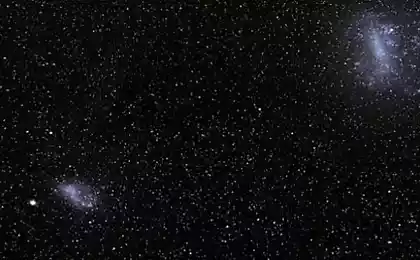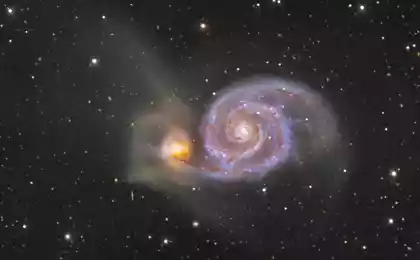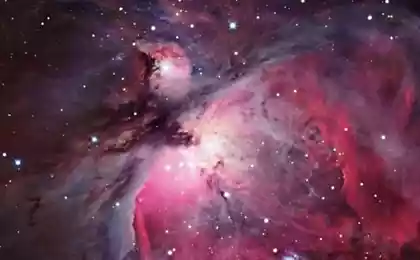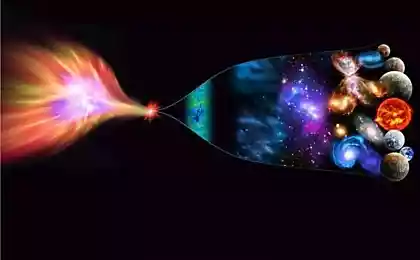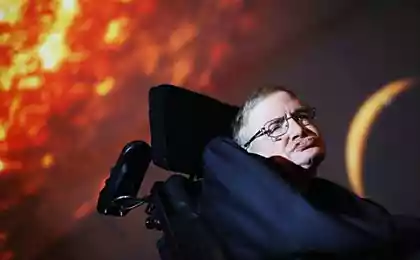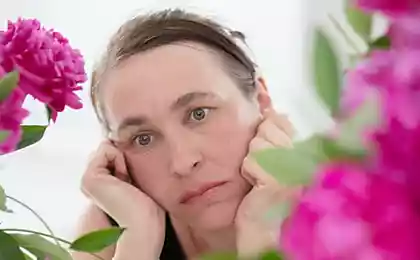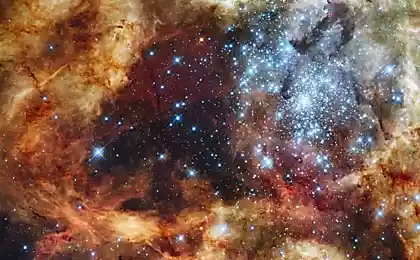761
The scientific world is on the verge of great discoveries: there is no us!
The universe is a hologram! This means that we do not!
There is increasing evidence that some part of the Universe can be special.

One of the cornerstones of modern astrophysics is the cosmological principle. According to him, observers on Earth see the same thing that observers from any other point of the Universe and that the laws of physics are the same everywhere.
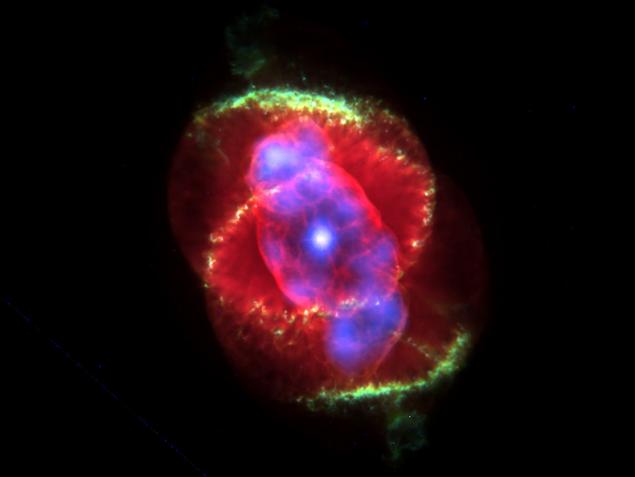
Many observations confirm this idea. For example, the universe looks more or less equally in all directions with approximately the same distribution of galaxies on all sides.
But in recent years, some cosmologists began to doubt the correctness of this principle.
They point to data obtained during the study of supernovae of type 1, which are removed from us with increasing speed, which indicates not only that the universe is expanding, but at an increasing acceleration of the expansion.
Curiously, the acceleration is not uniform for all directions. In some ways the universe is accelerating faster than the other.

But how can you trust this data? It is possible that in some areas we are seeing the statistical error, which will disappear with proper analysis of the data.
Rong-gen Cai and Zhong-Liang Tuo of the Institute for theoretical physics at the Chinese Academy of Sciences in Beijing, once again checked the data obtained from 557 supernovas from all parts of the Universe and has carried out repeated calculations.
Today, they confirmed the presence of heterogeneity. According to their calculations, the fastest acceleration occurs in the constellation Chanterelles in the Northern hemisphere. These data are consistent with findings from other studies, according to which there is heterogeneity in the cosmic microwave background radiation.
This may force cosmologists to come to a bold conclusion: the cosmological principle is wrong.
Raising the tantalizing question: why the universe is inhomogeneous and how it will affect current models of the cosmos?
Get ready for a galactic move
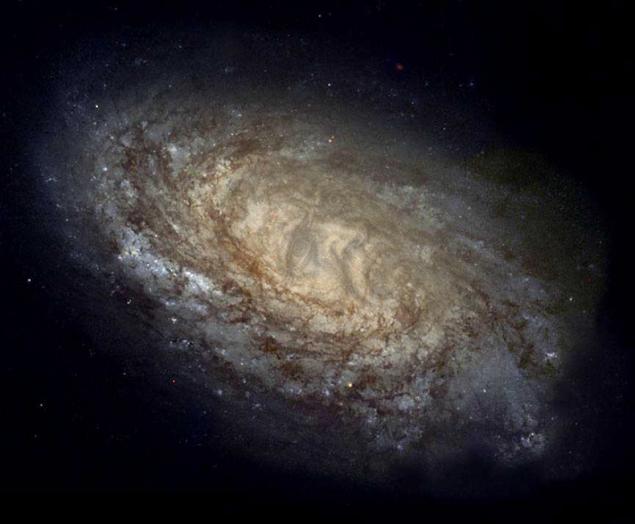
The milky way
A group of researchers from the US and Canada published a map suitable for the formation of life zones of the milky Way. Article scientists accepted for publication in the journal Astrobiology, and its Preprint available on the website arXiv.org.
According to modern concepts, the habitable zone of the galaxy (Galactic Habitable Zone – GHZ) is defined as the region where enough heavy elements to form planets with one hand, and which is not exposed to cosmic disasters on the other. The main such disasters, according to scientists, are supernova explosions, which can easily "sterilized" the entire planet.
In the study, researchers built a computer model of processes of formation of stars and supernovae of type Ia (white dwarfs in binary systems, stealing matter from a neighbor) and II (explosion of a star with a mass exceeding 8 solar). In the result, astrophysicists were able to identify regions of the milky Way, which in theory inhabitable.
In addition, the researchers found that around at least 1.5 percent of all stars in the galaxy (approximately 4.5 billion of 3×1011 stars) at different times could be habitable planets.
With 75 percent of these hypothetical planets should be located in tidal capture, that is constantly "look" at the star one side. Is there life on these planets is the subject of the dispute astrobiologists.
To calculate GHZ, the researchers used the same approach that is used in the analysis of habitable zones around stars. This area is usually called the region around a star where on the surface of a rocky planet water can exist in liquid form, according to Tape.<url>.
Our universe is a hologram. Is there a real reality?

The nature of a hologram – "whole in every part" – gives us an entirely new way of understanding the device and order of things. We see objects, for example, elementary particles are divided because we see only part of reality.
These particles – not separate "parts" but facets of a deeper unity.
At some deeper level of reality such particles – not individual objects, but as a continuation of something more fundamental.
Scientists came to the conclusion that elementary particles can interact with each other regardless of the distance not because they exchange some mysterious signal, but because their separation is an illusion.
If the particle separation is an illusion, then, on a deeper level, all things in the world is infinitely interconnected.
The electrons in the carbon atoms in our brain are associated with electrons of every salmon that swims, every heart that beats, and every star that shines in the sky.
The universe as a hologram means that we don't

The hologram says that we're a hologram.
Scientists from the Center for astrophysical research in the laboratory named Fermi (Fermilab) are working on creating a device golomer" (Holometer), with which they can refute everything that humanity now knows about the Universe.
With the help of the device "Golomer" experts hope to prove or disprove a crazy assumption that the three-dimensional Universe in the same form as we know it, simply does not exist, being nothing more than a kind of hologram. In other words, the surrounding reality is an illusion and nothing more.
...The theory that universe is a hologram, based on the appeared not so long ago the assumption that space and time in the Universe are not continuous.
They allegedly consist of separate parts of points — as if out of pixels, because of which it is impossible to increase the "scale image" of the Universe is infinite, penetrating deeper and deeper into the essence of things. To achieve a value scale universe turns something like a digital image of very poor quality — fuzzy, fuzzy.
Imagine an ordinary picture from a magazine. It looks like a continuous image, but beyond a certain zoom level, crumbles to the point of constituting a unified whole. And as our world supposedly made up of microscopic points in one beautiful, even convex image.
Amazing theory! And until recently it was regarded not serious. Only recent studies of black holes have convinced most researchers that the "holographic" theories have something.
The fact is that discovered by astronomers gradual evaporation of black holes with the passage of time has led to an information paradox — all contained information about the internals of the holes in this case would disappear.
This is contrary to the principle of conservation of information.
But Nobel laureate in physics Gerard ' t Hooft, based on the works of Professor of the University of Jerusalem Jacob Bekenstein proved that all information contained in the three-dimensional object can be stored in two-dimensional boundaries remaining after its destruction — just as a three-dimensional image of the object can be placed in a two-dimensional hologram.
THE SCIENTIST ONCE HAPPENED PHANTASM
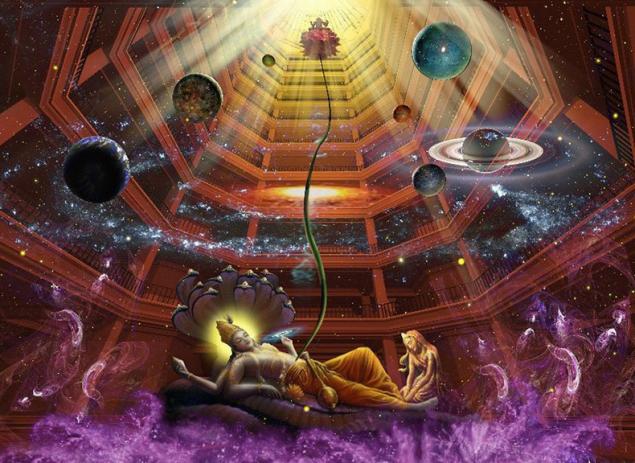
The first "crazy" idea of universal illusion was born at the University of London physicist David Bohm, associate of albert Einstein, in the mid-twentieth century.
According to his theory, the whole world is about the same as a hologram.
Like any arbitrarily small portion of a hologram contains the whole image a three-dimensional object, and each existing object "embedded" in each of its constituent parts.
— It follows from this that objective reality does not exist — then made a stunning conclusion, Professor Bohm. — Even despite its apparent density, the universe at its core — a phantasm, a gigantic, splendidly detailed hologram.
Recall that a hologram is a three-dimensional photograph made with a laser. To make it, first of all photographed object must be illuminated with laser light. Then a second laser beam, flowing into the reflected light from the object, gives an interference pattern (the alternation of minima and maxima of rays), which can be recorded.
The screenshot looks like a pointless represented light and dark lines. But it is necessary to illuminate the other laser beam, as immediately appears a three-dimensional image of the original object.
Three-dimensionality is not the only remarkable property inherent in the hologram.
If the hologram with the image, for example, of a tree cut in half and cover with a laser, each half will contain the whole image of the same tree the exact same size. If we continue to cut a hologram into smaller pieces, each of them we again find the image of the whole facility.
Unlike normal photographs, every portion of a hologram contains information about the whole thing, but with a proportionally corresponding decrease in definition.
— The principle of the hologram, "all in each part" allows us a completely new way to approach the issue of organization and order, " explained Bohm. — Throughout most of its history Western science has developed with the idea that the best way to understand a physical phenomenon whether a frog or an atom, is to dissect it and study its constituent parts.
The hologram showed us that some things in the Universe not amenable to study in this way. If we are going to dissect something arranged holographically, we will not receive parts of which it is composed, and get the same thing, but less accuracy.
AND THEN THERE WAS EXPLAINING ALL ASPECT
To the "crazy" idea of Bohm have pushed more and acclaimed at the time of the experiment with elementary particles. A physicist from the University of Paris Alan Aspect in 1982 found that in certain circumstances electrons are able to instantaneously communicate with each other regardless of the distance between them.
Doesn't matter, ten millimeters between them, or ten billion kilometers. Somehow each particle always knows what the other is doing. Confused only one problem with this: it violates Einstein's postulate on the maximum speed of propagation of interaction equal to the speed of light.
Since traveling faster than the speed of light is tantamount to breaking the time barrier, this daunting prospect has caused physicists strongly doubt the work Aspect.
But BOM has managed to find an explanation. According to him, the elementary particles interact at any distance not because they exchange certain mysterious signals among themselves, but because their separateness is illusory. He explained that at some deeper level of reality such particles are not separate objects, but are actually extensions of something more fundamental.
"His intricate theory Professor for a better understanding illustrated by the following example," wrote the author of the book "the Holographic universe" by Michael Talbot. — Imagine an aquarium with fish. Imagine also that you cannot see the aquarium directly, but can observe only two screens that transmit images from cameras placed one in front, the other side of the aquarium.
Looking at the screens, you can conclude that the fish on each of the screens are separate entities. Since the cameras transmit images under different corners, fishes look differently. But, continuing observation, after a while you will find that between two fishes on different screens there is a relationship.
When one fish turns, another also changes the direction of movement, a little different, but always the first. When one fish you see the full face, the other certainly in profile. If you do not have a complete picture of the situation, you probably will conclude that the fish must somehow instantly communicate with each other, it is not a fact of random coincidence".
— Apparent superluminal interaction between particles tells us that there is a deeper level of reality, hidden from us, " explained BOM the phenomenon of experiences of Aspect — a higher dimension than ours, as in analogy to an aquarium. Separate we see these particles only because we see only part of reality.
And the particles — not separate "parts" but facets of a deeper unity, which eventually also holographic and invisible as mentioned above wood.
And since everything in physical reality consists of these "phantoms", the observable universe itself is a projection, a hologram.
What else can carry a hologram — is not yet known.
Suppose, for example, that it is the matrix that gives rise to everything in the world, at least, it has all the elementary particles that took or will ever take any possible form of matter and energy, from snowflakes to quasars, from blue whales to gamma rays. It's like a universal supermarket, which has everything.
Although BOM and recognized that we have no way of knowing what else is fraught with a hologram, he took the liberty to say that we have no reason to assume that it is nothing more. In other words, probably, holographic level of the world — just one of the steps of the infinite evolution.
OPINION OPTIMIST

Psychologist Jack Kornfield, telling about his first meeting with the late Tibetan Buddhist teacher Kalu Rinpoche, remembers that they had this dialogue:
— Could you me explain in a few sentences the essence of Buddhist teachings?
I could do it, but you don't believe me and to understand what I'm talking about, you'll need many years.
— Anyway, explain, please, so I want to know. Rinpoche's answer was very brief:
— You really do not exist.
TIME CONSISTS OF GRANULES
But is it possible to "touch" the illusion with tools? It turned out, Yes. For several years in Germany on the gravitational telescope, built in Hannover (Germany) GEO600 conducting research on the detection of gravitational waves, fluctuations in space-time that create a supermassive space objects.
No waves over the years, however, could not be found. One reason — strange noises in the range from 300 to 1500 Hz, which for a long time fixes the detector. They are very interfere with his work.
The researchers searched in vain for the source of the noise, while with them, inadvertently contacted the Director of the Center for astrophysical research in the laboratory named Fermi Craig Hogan.
He said that he realized what it was. According to him, the holographic principle implies that space-time is not continuous line and, most likely, represents a set of micro-watersheds, beans, a kind of quanta of space-time.
— A precision instrument GEO600 today sufficient to fix the vacuum fluctuation occurring at the boundaries of quanta of space, most of those grains, which, if holographic principle is correct, is the universe — explained Professor Hogan.
According to him, GEO600 has stumbled upon the fundamental limit of space-time — the same "grain", like grainy magazine photos. And perceived this obstacle as 'noise'.
And Craig Hogan after the Boma repeats with conviction:
— If the GEO600 results match my expectations, we all do live in a huge hologram universal scale.
The reading of the detector while correspond exactly to his calculations, and I think the scientific world is on the verge of great discoveries.
The experts remind us that once extraneous noise, conclusions of the researchers themselves in the Bell Laboratory — a major research center in the field of telecommunications, electronic and computer systems — in experiments in 1964, have become a harbinger of global change science paradigm: it was discovered the background radiation that proved the hypothesis of the Big Bang.
A proof of the holographic Universe scientists expect, will work when the device "Golomer" at full power. Scientists hope that it will increase the amount of practical data and knowledge of this extraordinary discovery, related still of theoretical physics.
The detector is arranged as follows: Shine a laser through a beam splitter, from there two beams pass through two perpendicular body are reflected, come back, merge together and create an interference pattern, where any distortion informs about changing the relationship of the lengths of the bodies, as the gravitational wave passes through the body and compresses or stretches the space is different in different directions.
"Golomer" will increase the scale of space-time and see to confirm whether assumptions about the fractional structure of the Universe, based purely on mathematical findings, suggests Professor Hogan.
The first data obtained by using the new system, will start to arrive in the middle of this year.
THE OPINION OF THE PESSIMIST
The President of the Royal society, cosmologist and astrophysicist Martin Rees: "the Birth of the Universe will forever remain a mystery"
— We do not understand the laws of the universe. And never know how the universe began and what to expect. The hypothesis of the Big Bang, supposedly gave rise to the world around us, or that in our Universe there can be many others, or about the holographic world will remain unproven assumptions.
Undoubtedly, there are explanations of everything, but there is no such geniuses that would be able to understand them. The human mind is limited. And he reached his limit. Even today we are as far from understanding, for example, microstructure of a vacuum, and how many fish in the aquarium, who are absolutely unaware of how the environment in which they live.
I, for example, there is reason to suspect that space — the cell structure. And each cell in a trillion, trillion times smaller than an atom. But to prove or disprove it, or to understand how this design works, we can't. The problem is too complex beyond the human understanding – "the Russian space".
A computer model of the galaxy

After nine months of computation on a powerful supercomputer, astrophysicists have managed to create a computer model of a beautiful spiral galaxy that is a copy of our milky way.
In this case observed physics of the formation and evolution of our galaxy. This model, which was created by researchers from the University of California and Institute of theoretical physics in Zurich, to allow standing in front of the science problem, which originated from the prevailing cosmological model of the Universe.
"Previous attempts to create a massive disk galaxy like the milky way had failed, because the model was too large bulge (Central bulge), compared with the size of the disc," – said Javier Guedes, a graduate student of astronomy and astrophysics at the University of California and author of scientific articles about this model, called Eris (eng. "Eris"). The study will be published in the Astrophysical journal.
Eris is a massive spiral galaxy with a nucleus in the centre, which consists of bright stars and other structural objects, typical of such galaxies as the milky way. For parameters such as brightness, the ratio of the width of the center of the galaxy and the width of the disk, stellar composition and other properties, it coincides with the Milky way and other galaxies of this type.
As reported by the co-author, Piero Madau, Professor of astronomy and astrophysics at the University of California, on the implementation of the project was spent a lot of money that went to purchase 1.4 million available-hours of computational time on a supercomputer at the NASA Pleiades computer.
The obtained results allowed to confirm the theory of "cold dark matter", according to which the evolution of the structure of the Universe proceeded under the influence of gravitational interactions of the cold dark matter ("dark" due to the fact that it is impossible to see, but "cold" due to the fact that the particles move very slowly).
"This model monitors the interaction of more than 60 million particles of dark matter and gas. Its code covers the physics of such processes as gravity and hydrodynamics, star formation and supernova explosions – all at the highest resolution of all the cosmological models in the world," said Guedes. published
P. S. And remember, only by changing their consumption — together we change the world! ©
Source: matveychev-oleg.livejournal.com/3003278.html
There is increasing evidence that some part of the Universe can be special.

One of the cornerstones of modern astrophysics is the cosmological principle. According to him, observers on Earth see the same thing that observers from any other point of the Universe and that the laws of physics are the same everywhere.

Many observations confirm this idea. For example, the universe looks more or less equally in all directions with approximately the same distribution of galaxies on all sides.
But in recent years, some cosmologists began to doubt the correctness of this principle.
They point to data obtained during the study of supernovae of type 1, which are removed from us with increasing speed, which indicates not only that the universe is expanding, but at an increasing acceleration of the expansion.
Curiously, the acceleration is not uniform for all directions. In some ways the universe is accelerating faster than the other.

But how can you trust this data? It is possible that in some areas we are seeing the statistical error, which will disappear with proper analysis of the data.
Rong-gen Cai and Zhong-Liang Tuo of the Institute for theoretical physics at the Chinese Academy of Sciences in Beijing, once again checked the data obtained from 557 supernovas from all parts of the Universe and has carried out repeated calculations.
Today, they confirmed the presence of heterogeneity. According to their calculations, the fastest acceleration occurs in the constellation Chanterelles in the Northern hemisphere. These data are consistent with findings from other studies, according to which there is heterogeneity in the cosmic microwave background radiation.
This may force cosmologists to come to a bold conclusion: the cosmological principle is wrong.
Raising the tantalizing question: why the universe is inhomogeneous and how it will affect current models of the cosmos?
Get ready for a galactic move

The milky way
A group of researchers from the US and Canada published a map suitable for the formation of life zones of the milky Way. Article scientists accepted for publication in the journal Astrobiology, and its Preprint available on the website arXiv.org.
According to modern concepts, the habitable zone of the galaxy (Galactic Habitable Zone – GHZ) is defined as the region where enough heavy elements to form planets with one hand, and which is not exposed to cosmic disasters on the other. The main such disasters, according to scientists, are supernova explosions, which can easily "sterilized" the entire planet.
In the study, researchers built a computer model of processes of formation of stars and supernovae of type Ia (white dwarfs in binary systems, stealing matter from a neighbor) and II (explosion of a star with a mass exceeding 8 solar). In the result, astrophysicists were able to identify regions of the milky Way, which in theory inhabitable.
In addition, the researchers found that around at least 1.5 percent of all stars in the galaxy (approximately 4.5 billion of 3×1011 stars) at different times could be habitable planets.
With 75 percent of these hypothetical planets should be located in tidal capture, that is constantly "look" at the star one side. Is there life on these planets is the subject of the dispute astrobiologists.
To calculate GHZ, the researchers used the same approach that is used in the analysis of habitable zones around stars. This area is usually called the region around a star where on the surface of a rocky planet water can exist in liquid form, according to Tape.<url>.
Our universe is a hologram. Is there a real reality?

The nature of a hologram – "whole in every part" – gives us an entirely new way of understanding the device and order of things. We see objects, for example, elementary particles are divided because we see only part of reality.
These particles – not separate "parts" but facets of a deeper unity.
At some deeper level of reality such particles – not individual objects, but as a continuation of something more fundamental.
Scientists came to the conclusion that elementary particles can interact with each other regardless of the distance not because they exchange some mysterious signal, but because their separation is an illusion.
If the particle separation is an illusion, then, on a deeper level, all things in the world is infinitely interconnected.
The electrons in the carbon atoms in our brain are associated with electrons of every salmon that swims, every heart that beats, and every star that shines in the sky.
The universe as a hologram means that we don't

The hologram says that we're a hologram.
Scientists from the Center for astrophysical research in the laboratory named Fermi (Fermilab) are working on creating a device golomer" (Holometer), with which they can refute everything that humanity now knows about the Universe.
With the help of the device "Golomer" experts hope to prove or disprove a crazy assumption that the three-dimensional Universe in the same form as we know it, simply does not exist, being nothing more than a kind of hologram. In other words, the surrounding reality is an illusion and nothing more.
...The theory that universe is a hologram, based on the appeared not so long ago the assumption that space and time in the Universe are not continuous.
They allegedly consist of separate parts of points — as if out of pixels, because of which it is impossible to increase the "scale image" of the Universe is infinite, penetrating deeper and deeper into the essence of things. To achieve a value scale universe turns something like a digital image of very poor quality — fuzzy, fuzzy.
Imagine an ordinary picture from a magazine. It looks like a continuous image, but beyond a certain zoom level, crumbles to the point of constituting a unified whole. And as our world supposedly made up of microscopic points in one beautiful, even convex image.
Amazing theory! And until recently it was regarded not serious. Only recent studies of black holes have convinced most researchers that the "holographic" theories have something.
The fact is that discovered by astronomers gradual evaporation of black holes with the passage of time has led to an information paradox — all contained information about the internals of the holes in this case would disappear.
This is contrary to the principle of conservation of information.
But Nobel laureate in physics Gerard ' t Hooft, based on the works of Professor of the University of Jerusalem Jacob Bekenstein proved that all information contained in the three-dimensional object can be stored in two-dimensional boundaries remaining after its destruction — just as a three-dimensional image of the object can be placed in a two-dimensional hologram.
THE SCIENTIST ONCE HAPPENED PHANTASM

The first "crazy" idea of universal illusion was born at the University of London physicist David Bohm, associate of albert Einstein, in the mid-twentieth century.
According to his theory, the whole world is about the same as a hologram.
Like any arbitrarily small portion of a hologram contains the whole image a three-dimensional object, and each existing object "embedded" in each of its constituent parts.
— It follows from this that objective reality does not exist — then made a stunning conclusion, Professor Bohm. — Even despite its apparent density, the universe at its core — a phantasm, a gigantic, splendidly detailed hologram.
Recall that a hologram is a three-dimensional photograph made with a laser. To make it, first of all photographed object must be illuminated with laser light. Then a second laser beam, flowing into the reflected light from the object, gives an interference pattern (the alternation of minima and maxima of rays), which can be recorded.
The screenshot looks like a pointless represented light and dark lines. But it is necessary to illuminate the other laser beam, as immediately appears a three-dimensional image of the original object.
Three-dimensionality is not the only remarkable property inherent in the hologram.
If the hologram with the image, for example, of a tree cut in half and cover with a laser, each half will contain the whole image of the same tree the exact same size. If we continue to cut a hologram into smaller pieces, each of them we again find the image of the whole facility.
Unlike normal photographs, every portion of a hologram contains information about the whole thing, but with a proportionally corresponding decrease in definition.
— The principle of the hologram, "all in each part" allows us a completely new way to approach the issue of organization and order, " explained Bohm. — Throughout most of its history Western science has developed with the idea that the best way to understand a physical phenomenon whether a frog or an atom, is to dissect it and study its constituent parts.
The hologram showed us that some things in the Universe not amenable to study in this way. If we are going to dissect something arranged holographically, we will not receive parts of which it is composed, and get the same thing, but less accuracy.
AND THEN THERE WAS EXPLAINING ALL ASPECT
To the "crazy" idea of Bohm have pushed more and acclaimed at the time of the experiment with elementary particles. A physicist from the University of Paris Alan Aspect in 1982 found that in certain circumstances electrons are able to instantaneously communicate with each other regardless of the distance between them.
Doesn't matter, ten millimeters between them, or ten billion kilometers. Somehow each particle always knows what the other is doing. Confused only one problem with this: it violates Einstein's postulate on the maximum speed of propagation of interaction equal to the speed of light.
Since traveling faster than the speed of light is tantamount to breaking the time barrier, this daunting prospect has caused physicists strongly doubt the work Aspect.
But BOM has managed to find an explanation. According to him, the elementary particles interact at any distance not because they exchange certain mysterious signals among themselves, but because their separateness is illusory. He explained that at some deeper level of reality such particles are not separate objects, but are actually extensions of something more fundamental.
"His intricate theory Professor for a better understanding illustrated by the following example," wrote the author of the book "the Holographic universe" by Michael Talbot. — Imagine an aquarium with fish. Imagine also that you cannot see the aquarium directly, but can observe only two screens that transmit images from cameras placed one in front, the other side of the aquarium.
Looking at the screens, you can conclude that the fish on each of the screens are separate entities. Since the cameras transmit images under different corners, fishes look differently. But, continuing observation, after a while you will find that between two fishes on different screens there is a relationship.
When one fish turns, another also changes the direction of movement, a little different, but always the first. When one fish you see the full face, the other certainly in profile. If you do not have a complete picture of the situation, you probably will conclude that the fish must somehow instantly communicate with each other, it is not a fact of random coincidence".
— Apparent superluminal interaction between particles tells us that there is a deeper level of reality, hidden from us, " explained BOM the phenomenon of experiences of Aspect — a higher dimension than ours, as in analogy to an aquarium. Separate we see these particles only because we see only part of reality.
And the particles — not separate "parts" but facets of a deeper unity, which eventually also holographic and invisible as mentioned above wood.
And since everything in physical reality consists of these "phantoms", the observable universe itself is a projection, a hologram.
What else can carry a hologram — is not yet known.
Suppose, for example, that it is the matrix that gives rise to everything in the world, at least, it has all the elementary particles that took or will ever take any possible form of matter and energy, from snowflakes to quasars, from blue whales to gamma rays. It's like a universal supermarket, which has everything.
Although BOM and recognized that we have no way of knowing what else is fraught with a hologram, he took the liberty to say that we have no reason to assume that it is nothing more. In other words, probably, holographic level of the world — just one of the steps of the infinite evolution.
OPINION OPTIMIST

Psychologist Jack Kornfield, telling about his first meeting with the late Tibetan Buddhist teacher Kalu Rinpoche, remembers that they had this dialogue:
— Could you me explain in a few sentences the essence of Buddhist teachings?
I could do it, but you don't believe me and to understand what I'm talking about, you'll need many years.
— Anyway, explain, please, so I want to know. Rinpoche's answer was very brief:
— You really do not exist.
TIME CONSISTS OF GRANULES
But is it possible to "touch" the illusion with tools? It turned out, Yes. For several years in Germany on the gravitational telescope, built in Hannover (Germany) GEO600 conducting research on the detection of gravitational waves, fluctuations in space-time that create a supermassive space objects.
No waves over the years, however, could not be found. One reason — strange noises in the range from 300 to 1500 Hz, which for a long time fixes the detector. They are very interfere with his work.
The researchers searched in vain for the source of the noise, while with them, inadvertently contacted the Director of the Center for astrophysical research in the laboratory named Fermi Craig Hogan.
He said that he realized what it was. According to him, the holographic principle implies that space-time is not continuous line and, most likely, represents a set of micro-watersheds, beans, a kind of quanta of space-time.
— A precision instrument GEO600 today sufficient to fix the vacuum fluctuation occurring at the boundaries of quanta of space, most of those grains, which, if holographic principle is correct, is the universe — explained Professor Hogan.
According to him, GEO600 has stumbled upon the fundamental limit of space-time — the same "grain", like grainy magazine photos. And perceived this obstacle as 'noise'.
And Craig Hogan after the Boma repeats with conviction:
— If the GEO600 results match my expectations, we all do live in a huge hologram universal scale.
The reading of the detector while correspond exactly to his calculations, and I think the scientific world is on the verge of great discoveries.
The experts remind us that once extraneous noise, conclusions of the researchers themselves in the Bell Laboratory — a major research center in the field of telecommunications, electronic and computer systems — in experiments in 1964, have become a harbinger of global change science paradigm: it was discovered the background radiation that proved the hypothesis of the Big Bang.
A proof of the holographic Universe scientists expect, will work when the device "Golomer" at full power. Scientists hope that it will increase the amount of practical data and knowledge of this extraordinary discovery, related still of theoretical physics.
The detector is arranged as follows: Shine a laser through a beam splitter, from there two beams pass through two perpendicular body are reflected, come back, merge together and create an interference pattern, where any distortion informs about changing the relationship of the lengths of the bodies, as the gravitational wave passes through the body and compresses or stretches the space is different in different directions.
"Golomer" will increase the scale of space-time and see to confirm whether assumptions about the fractional structure of the Universe, based purely on mathematical findings, suggests Professor Hogan.
The first data obtained by using the new system, will start to arrive in the middle of this year.
THE OPINION OF THE PESSIMIST
The President of the Royal society, cosmologist and astrophysicist Martin Rees: "the Birth of the Universe will forever remain a mystery"
— We do not understand the laws of the universe. And never know how the universe began and what to expect. The hypothesis of the Big Bang, supposedly gave rise to the world around us, or that in our Universe there can be many others, or about the holographic world will remain unproven assumptions.
Undoubtedly, there are explanations of everything, but there is no such geniuses that would be able to understand them. The human mind is limited. And he reached his limit. Even today we are as far from understanding, for example, microstructure of a vacuum, and how many fish in the aquarium, who are absolutely unaware of how the environment in which they live.
I, for example, there is reason to suspect that space — the cell structure. And each cell in a trillion, trillion times smaller than an atom. But to prove or disprove it, or to understand how this design works, we can't. The problem is too complex beyond the human understanding – "the Russian space".
A computer model of the galaxy

After nine months of computation on a powerful supercomputer, astrophysicists have managed to create a computer model of a beautiful spiral galaxy that is a copy of our milky way.
In this case observed physics of the formation and evolution of our galaxy. This model, which was created by researchers from the University of California and Institute of theoretical physics in Zurich, to allow standing in front of the science problem, which originated from the prevailing cosmological model of the Universe.
"Previous attempts to create a massive disk galaxy like the milky way had failed, because the model was too large bulge (Central bulge), compared with the size of the disc," – said Javier Guedes, a graduate student of astronomy and astrophysics at the University of California and author of scientific articles about this model, called Eris (eng. "Eris"). The study will be published in the Astrophysical journal.
Eris is a massive spiral galaxy with a nucleus in the centre, which consists of bright stars and other structural objects, typical of such galaxies as the milky way. For parameters such as brightness, the ratio of the width of the center of the galaxy and the width of the disk, stellar composition and other properties, it coincides with the Milky way and other galaxies of this type.
As reported by the co-author, Piero Madau, Professor of astronomy and astrophysics at the University of California, on the implementation of the project was spent a lot of money that went to purchase 1.4 million available-hours of computational time on a supercomputer at the NASA Pleiades computer.
The obtained results allowed to confirm the theory of "cold dark matter", according to which the evolution of the structure of the Universe proceeded under the influence of gravitational interactions of the cold dark matter ("dark" due to the fact that it is impossible to see, but "cold" due to the fact that the particles move very slowly).
"This model monitors the interaction of more than 60 million particles of dark matter and gas. Its code covers the physics of such processes as gravity and hydrodynamics, star formation and supernova explosions – all at the highest resolution of all the cosmological models in the world," said Guedes. published
P. S. And remember, only by changing their consumption — together we change the world! ©
Source: matveychev-oleg.livejournal.com/3003278.html

